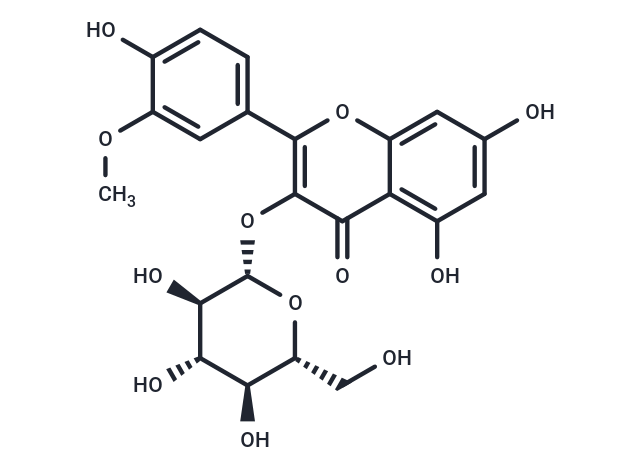Shopping Cart
Remove All Your shopping cart is currently empty
Your shopping cart is currently empty
Isorhamnetin-3-O-glucoside (Isorhamnetin-3-O-beta-D-Glucoside) inhibits the activity of alpha-glucosidase from rat intestine; it exhibits a potent rat lens aldose reductase (RLAR) inhibition in vitro, its IC(50) being 1.4 microM and has inhibitory effects of sorbitol accumulation, suggests that it is a leading compound for further study as a new drug for the prevention and/or treatment of diabetes and its complications.

| Pack Size | Price | USA Warehouse | Global Warehouse | Quantity |
|---|---|---|---|---|
| 1 mg | $72 | In Stock | In Stock | |
| 5 mg | $247 | In Stock | In Stock | |
| 10 mg | $413 | In Stock | In Stock | |
| 25 mg | $828 | In Stock | In Stock | |
| 50 mg | $1,120 | - | In Stock | |
| 1 mL x 10 mM (in DMSO) | $258 | In Stock | In Stock |
| Description | Isorhamnetin-3-O-glucoside (Isorhamnetin-3-O-beta-D-Glucoside) inhibits the activity of alpha-glucosidase from rat intestine; it exhibits a potent rat lens aldose reductase (RLAR) inhibition in vitro, its IC(50) being 1.4 microM and has inhibitory effects of sorbitol accumulation, suggests that it is a leading compound for further study as a new drug for the prevention and/or treatment of diabetes and its complications. |
| In vitro | The inhibitory effects of compounds from Salicornia herbacea (Chenopodiaceae) on rat lens aldose reductase (RLAR) and sorbitol accumulation in streptozotocin-induced diabetic rat tissues were investigated. METHODS AND RESULTS:The various fractions from the MeOH extract of S. herbacea were tested for their effects on RLAR in vitro. Among them, the EtOAc fraction was found to exhibit a potent RLAR inhibition (IC(50)=0.75 microg/ml), from which an active principle as a potent AR inhibitor was isolated and its chemical structure was elucidated as Isorhamnetin-3-O-beta-D-Glucoside (1) by spectral analysis. Compound 1 exhibited a potent RLAR inhibition in vitro, its IC(50) being 1.4 microM. Compound 1, when administered orally at 25 mg/kg in streptozotocin (STZ)-induced diabetic rats, caused not only a significant inhibition of serum glucose concentration but also sorbitol accumulation in the lenses, red blood cells (RBC), and sciatic nerves. CONCLUSIONS:These results indicate that compound 1 from S. herbacea is a leading compound for further study as a new drug for the prevention and/or treatment of diabetes and its complications. |
| Synonyms | Isorhamnetin-3-O-beta-D-Glucoside |
| Molecular Weight | 478.4 |
| Formula | C22H22O12 |
| Cas No. | 5041-82-7 |
| Smiles | COc1cc(ccc1O)-c1oc2cc(O)cc(O)c2c(=O)c1O[C@@H]1O[C@H](CO)[C@@H](O)[C@H](O)[C@H]1O |
| Relative Density. | 1.75 g/cm3 (Predicted) |
| Color | White |
| Appearance | Solid |
| Storage | Powder: -20°C for 3 years | In solvent: -80°C for 1 year | Shipping with blue ice/Shipping at ambient temperature. | |||||||||||||||||||||||||||||||||||
| Solubility Information | DMSO: 250 mg/mL (522.58 mM), Sonication is recommended. | |||||||||||||||||||||||||||||||||||
| In Vivo Formulation | 10% DMSO+40% PEG300+5% Tween 80+45% Saline: 5 mg/mL (10.45 mM), Sonication is recommended. Please add the solvents sequentially, clarifying the solution as much as possible before adding the next one. Dissolve by heating and/or sonication if necessary. Working solution is recommended to be prepared and used immediately. The formulation provided above is for reference purposes only. In vivo formulations may vary and should be modified based on specific experimental conditions. | |||||||||||||||||||||||||||||||||||
Solution Preparation Table | ||||||||||||||||||||||||||||||||||||
DMSO
| ||||||||||||||||||||||||||||||||||||
| Size | Quantity | Unit Price | Amount | Operation |
|---|

Copyright © 2015-2025 TargetMol Chemicals Inc. All Rights Reserved.